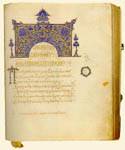|
|
| Greek Manuscripts |
1346 Iviron Monastery, Cod. 1384 Parchment, 29.5 x 23.5 cm. ff. 262 (or 265) |
|

|
Scribe. The writer of this codex is the well-known scribe Chariton, who belonged to the scriptorium of the Hodegon Monastery in the centre of Constantinople, near Ayia Sophia. This scriptorium had close ties with the Palaeologi. In a way, it was the 'National Printing-House' of the Palace. Chariton's activity as a scribe spans the period 1319-1346, and precedes that of Ioasaph, the scriptorium's most important scribe. It is possible, as L. Politis supposes, that Chariton was Ioasaph's teacher. Another 11 manuscripts by Chariton are known to exist, for which L. Politis includes a catalogue in his study on the Hodegon Monastery (see bibliography). Chariton, like the other scribes at the monastery, wrote manuscripts for members of the royal family and other figures of high standing, as is the case in the present manuscript. Scribe's notes. On fol. 261v (or 264v, according to another foliation): 'The gift is from God and the labour by Chariton.' On fol. 262v (or 265v, according to another foliation):
'+ This psalter by the divinely inspired King David
'+ This psalter of dazzling beauty In another hand: 'That is, in the year anno mundi 6854 (= A.D. 1346).' The donor of the manuscript, Anna Palaeologina, was Anne of Savoy, the second wife of Andronicos III Palaeologos (1328-1341) and mother of John V (1341-1376), who is mentioned in the note in the words 'and the king's son'. The manuscript was written during the civil war of 1341-1347, which broke out when the great domestikos John Cantacuzenos claimed (and eventually secured) the throne. Decoration. The manuscript is richly decorated, with gold writing (the whole of the first page, the inscriptions and other parts are inscribed in gold letters) and elegant initial letters etc. | |
|
Bibliography: Lambros 1900, p. 279. Lambros 1902-3, pp. 248-9. Vogel - Gardthausen 1909, pp. 425-6. Politis 1958, pp. 261-5. Politis 1963, pp. 124-5. Thesauroi 1975, p. 328 (bibliography). I.M.A.G.E.S. 1981, p. 167 (bibliography). RGK 1981, no. 378. RGK 1989, no. 522 (bibliography).
| ||
| B.A. | ||
| Index of exhibits of Monastery of Iviron 14th century |
||
Reference address : https://www.elpenor.org/athos/en/e218er19.asp